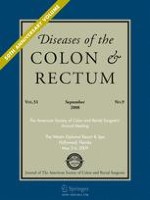Erschienen in:

01.09.2008 | Original Contribution
Colectomy and Ileorectal Anastomosis is still an Option for Selected Patients with Familial Adenomatous Polyposis
verfasst von:
Steffen Bülow, M.D., D.M.Sc., Charlotte Bülow, M.D., Hans Vasen, M.D., D.M.Sc., Heikki Järvinen, M.D., D.M.Sc., Jan Björk, M.D., D.M.Sc., Ib Jarle Christensen, M.Stat.
Erschienen in:
Diseases of the Colon & Rectum
|
Ausgabe 9/2008
Einloggen, um Zugang zu erhalten
Abstract
Purpose
The risk of rectal cancer after colectomy and ileorectal anastomosis may be reduced in the last decades, as patients with severe polyposis now have an ileoanal pouch. We have reevaluated the risk of rectal cancer and proctectomy for all causes according to the year of operation.
Methods
On the basis of the year of operation in 776 patients with ileorectal anastomosis and 471 pouch patients in Denmark, Finland, Holland, and Sweden, the “pouch period” was defined to start in 1990. Ileorectal anastomosis follow-up data was captured by May 31, 2006. The cumulative risk of rectal cancer and proctectomy was compared before and after 1990 by Kaplan-Meier analysis.
Results
In the prepouch period 56/576 patients (10 percent) developed rectal cancer, vs. 4/200 (2 percent) in the pouch period. Neither the cumulative risk of rectal cancer (p = 0.07) nor the cumulative risk of proctectomy (p = 0.17) changed. However, in females the cumulative risk of rectal cancer (p = 0.04) and of proctectomy (p = 0.03) were lower in the pouch period.
Conclusions
Since the introduction of the ileoanal pouch rectal cancer has decreased after ileorectal anastomosis, but only statistically significant in females. This indicates that ileorectal anastomosis may still be justified in selected patients with mild adenomatosis, especially in young females.